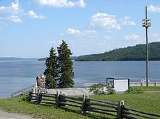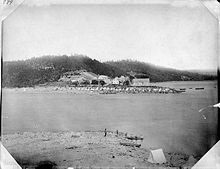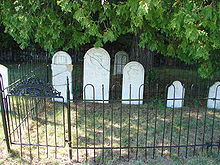
Fort Témiscamingue
Encyclopedia
Fort Témiscamingue was a trading post
from the 17th century in Duhamel-Ouest, Quebec
, near Ville-Marie
, Canada, located on the fur trade
route on the east shore of Lake Timiskaming
. Nowadays, the fort is a National Historic Site of Canada.
 Circa 1679, the government of New France
Circa 1679, the government of New France
established a fort on Lake Timiskaming to compete with the English posts on the Hudson Bay
, but was destroyed by the Iroquois
in 1688. In 1720, a new Fort Témiscamingue was founded by French merchants on a strategic location where the two shores of Lake Timiskaming come closer than 250 metres (820.2 ft) to each other, a former Algonquin encampment site called "Obadjiwan Point" (meaning "the strait where the current flows"). This became a centre for the fur trade
route from Montreal
to Hudson Bay, roughly located halfway between these two: both about 20 days of canoeing and portaging
away.
After the fall of New France in 1760, the North West Company
took over the fort and gained a virtual trade monopoly by the 1790s. In 1821, the fort came into the hands of the Hudson's Bay Company
.
A Roman Catholic mission originally established at Fort Témiscamingue on the eastern shore of Lake Timiskaming in present-day Quebec was relocated to the Ontario shore of the lake in 1863. The mission comprised a presbytery for the Oblate fathers, a small hospital operated by two Grey Sisters of the Cross, and eventually a frame church.
In 1864, it became the seat of its district. By the end of the 19th century, lumbermen, missionaries, and settlers succeeded the fur traders and the fort's role as a trading post gradually became obsolete. In 1902, it closed down.
 Declared a national historic site in 1931, the site is notable for its cultural and natural heritage. The park's territory is mainly three distinct natural areas: the plateau, the escarpments and the lowlands. Overall, over 80% of the total area of the park is a wooded area with approximately 20 different stands and a number of plants from the climactic forest type of the Laurentian maple stand and the Upper St. Lawrence forest sub-region. Of particular interest is a forest of cedar trunks so twisted that it was nicknamed the "Enchanted Forest".
Declared a national historic site in 1931, the site is notable for its cultural and natural heritage. The park's territory is mainly three distinct natural areas: the plateau, the escarpments and the lowlands. Overall, over 80% of the total area of the park is a wooded area with approximately 20 different stands and a number of plants from the climactic forest type of the Laurentian maple stand and the Upper St. Lawrence forest sub-region. Of particular interest is a forest of cedar trunks so twisted that it was nicknamed the "Enchanted Forest".
Of the fort itself not much remained, but a modern visitor's centre, exhibits, and reenactments highlight the cultural history of the place.
Trading post
A trading post was a place or establishment in historic Northern America where the trading of goods took place. The preferred travel route to a trading post or between trading posts, was known as a trade route....
from the 17th century in Duhamel-Ouest, Quebec
Duhamel-Ouest, Quebec
Duhamel-Ouest is a municipality in northwestern Quebec, Canada in the Témiscamingue Regional County Municipality.Located at a narrows of Lake Timiskaming, Duhamel-Ouest is home to the Fort Témiscamingue National Historic Site.-Demographics:Population trend:...
, near Ville-Marie
Ville-Marie, Quebec
Ville-Marie is a town on Lake Temiscaming in western Quebec, Canada. It is the largest city and seat of the Témiscamingue Regional County Municipality, Quebec. As one of the oldest towns in the Abitibi-Témiscamingue region, it is considered the cradle of north-western Quebec and nicknamed "Pearl of...
, Canada, located on the fur trade
Fur trade
The fur trade is a worldwide industry dealing in the acquisition and sale of animal fur. Since the establishment of world market for in the early modern period furs of boreal, polar and cold temperate mammalian animals have been the most valued...
route on the east shore of Lake Timiskaming
Lake Timiskaming
Lake Timiskaming is a large freshwater lake on the provincial border between Ontario and Quebec, Canada. The lake, which forms part of the Ottawa River, is in length and covers an area of almost . Its water level ranges between and above sea-level, with a mean annual average of . The lake is...
. Nowadays, the fort is a National Historic Site of Canada.
History

New France
New France was the area colonized by France in North America during a period beginning with the exploration of the Saint Lawrence River by Jacques Cartier in 1534 and ending with the cession of New France to Spain and Great Britain in 1763...
established a fort on Lake Timiskaming to compete with the English posts on the Hudson Bay
Hudson Bay
Hudson Bay , sometimes called Hudson's Bay, is a large body of saltwater in northeastern Canada. It drains a very large area, about , that includes parts of Ontario, Quebec, Saskatchewan, Alberta, most of Manitoba, southeastern Nunavut, as well as parts of North Dakota, South Dakota, Minnesota,...
, but was destroyed by the Iroquois
Iroquois
The Iroquois , also known as the Haudenosaunee or the "People of the Longhouse", are an association of several tribes of indigenous people of North America...
in 1688. In 1720, a new Fort Témiscamingue was founded by French merchants on a strategic location where the two shores of Lake Timiskaming come closer than 250 metres (820.2 ft) to each other, a former Algonquin encampment site called "Obadjiwan Point" (meaning "the strait where the current flows"). This became a centre for the fur trade
Fur trade
The fur trade is a worldwide industry dealing in the acquisition and sale of animal fur. Since the establishment of world market for in the early modern period furs of boreal, polar and cold temperate mammalian animals have been the most valued...
route from Montreal
Montreal
Montreal is a city in Canada. It is the largest city in the province of Quebec, the second-largest city in Canada and the seventh largest in North America...
to Hudson Bay, roughly located halfway between these two: both about 20 days of canoeing and portaging
Portage
Portage or portaging refers to the practice of carrying watercraft or cargo over land to avoid river obstacles, or between two bodies of water. A place where this carrying occurs is also called a portage; a person doing the carrying is called a porter.The English word portage is derived from the...
away.
After the fall of New France in 1760, the North West Company
North West Company
The North West Company was a fur trading business headquartered in Montreal from 1779 to 1821. It competed with increasing success against the Hudson's Bay Company in what was to become Western Canada...
took over the fort and gained a virtual trade monopoly by the 1790s. In 1821, the fort came into the hands of the Hudson's Bay Company
Hudson's Bay Company
The Hudson's Bay Company , abbreviated HBC, or "The Bay" is the oldest commercial corporation in North America and one of the oldest in the world. A fur trading business for much of its existence, today Hudson's Bay Company owns and operates retail stores throughout Canada...
.
A Roman Catholic mission originally established at Fort Témiscamingue on the eastern shore of Lake Timiskaming in present-day Quebec was relocated to the Ontario shore of the lake in 1863. The mission comprised a presbytery for the Oblate fathers, a small hospital operated by two Grey Sisters of the Cross, and eventually a frame church.
In 1864, it became the seat of its district. By the end of the 19th century, lumbermen, missionaries, and settlers succeeded the fur traders and the fort's role as a trading post gradually became obsolete. In 1902, it closed down.
National historic site

Of the fort itself not much remained, but a modern visitor's centre, exhibits, and reenactments highlight the cultural history of the place.

